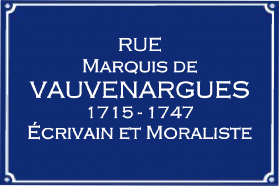
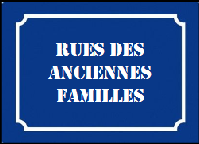

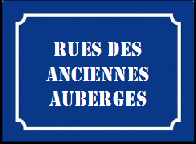

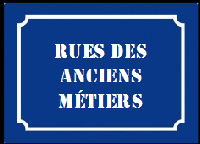




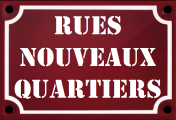





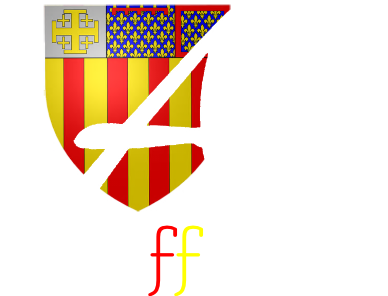






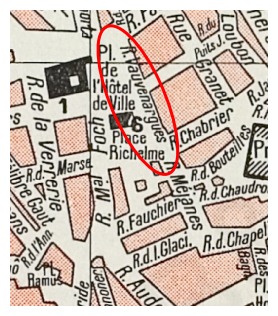

Luc de CLAPIERS, marquis de VAUVENARGUES est né à Aix le 5 août 1715 Rue FRUCHERIE qui porte désormais son nom.
Son père, Joseph de CLAPIERS, était premier consul d’Aix lorsque la peste de 1720 se déclara. En remerciement pour son dévouement et son aide à la population aixoise, LOUIS XV lui accorda le noble titre de marquis de VAUVENARGUES ainsi que le Château en 1722.
À 20 ans, le jeune Luc s’engage dans les troupes du roi. Mais sa santé est fragile et après une dizaine d’années de souffrances, il est contraint à démissionner de l’armée. C’est alors qu’il va être défiguré par la variole, et perdra presque la vue.
En 1745, âgé de 30 ans, il se fixe alors à Paris et devient un homme de lettres. Il se liera d’une amitié solide, basée sur un respect mutuel, avec le non moins célèbre VOLTAIRE. Il publie : Introduction à la Connaissance de l’Esprit Humain, Réflexions et Maximes, Réflexions sur Divers Sujets, Conseils à un Jeune Homme ... Sa notoriété fut posthume car il vécut pauvrement à Paris.
Le marquis de VAUVENARGUES meurt le 28 mai 1747, à l’âge de 32 ans à peine.
Le saviez-
En 1958, le Château de Vauvenargues, à quelques kilomètres d'Aix, acquit sa renommée lorsqu'il deviendra la propriété du peintre Pablo PICASSO qui y est enterré dans le parc en compagnie de sa femme.
La maison de naissance du marquis de VAUVENARGUES se trouve-
Le conseil municipal mentionne le n°34 alors qu’à la lecture de ROUX-
Remarque d’odonymie :
Le conseil municipal mentionne le risque de confusion en ce qui concerne VAUVENARGUES. Parle-
À voir :
Au n°17 : le nom de l'ancienne RUE DE LA FRUCHARIÉ gravé dans la pierre de la façade. Elle était la partie de la Place aux HERBES où se vendaient les fruits avant que les deux soient réunis sous la même dénomination Place Marie-
Luc de CLAPIERS, marquis de VAUVENARGUES was born in Aix on August 5, 1715 Rue FRUCHERIE which now bears his name.
His father, Joseph de CLAPIERS, was First Consul in Aix when the plague of 1720 broke out. In gratitude for his dedication and his help to the people of Aix, LOUIS XV granted him the noble title of Marquis de VAUVENARGUES as well as the Château in 1722.
At 20, young Luc enlisted in the king's troops. But his health is fragile and after ten years of suffering, he is forced to resign from the army. Then he will be disfigured with smallpox, and will almost lose his sight.
In 1745, aged 30, he settled in Paris and became a man of letters. He will form a solid friendship, based on mutual respect, with the no less famous VOLTAIRE. He publishes: Introduction to the Knowledge of the Human Spirit, Reflections and Maxims, Reflections on Various Subjects, Advice to a Young Man ... His fame was posthumous because he lived poorly in Paris.
The Marquis de VAUVENARGUES died on May 28, 1747, at the age of barely 32.
Did you know ?
In 1958, the Château de Vauvenargues, a few kilometers from Aix, acquired its fame when it became the property of the painter Pablo PICASSO who is buried there in the park with his wife.
Is the birthplace of the Marquis de VAUVENARGUES located at n ° 34 or 26?
The municipal council mentions n ° 34 while reading ROUX-
Odonymy note:
The municipal council mentions the risk of confusion with regard to VAUVENARGUES. Are we talking about the locality or the Marquis? The path that leads to this village will be called VAUVENARGUES crosses since this decision. Therefore, we must wonder why we did not add "marquis" to the new plaque in order to dispel any confusion?
To see :
At n ° 17: the name of the former Rue de la FRUCHARIÉ engraved in the stone of the facade. It was the part of the Place aux HERBES where the fruits were sold before the two were united under the same name Place Marie-
